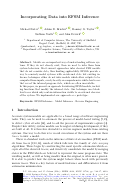Incorporating Data into EFSM Inference
by Michael Foster, Achim D. Brucker, Ramsay G. Taylor, Siobhán North, and John Derrick
 Models are an important way of understanding software systems. If they do not already exist, then we need to infer them from system behaviour. Most current approaches infer classical FSM models that do not consider data, thus limiting applicability. EFSMs provide a way to concisely model systems with an internal state but existing inference techniques either do not infer models which allow outputs to be computed from inputs, or rely heavily on comprehensive white-box traces that reveal the internal program state, which are often unavailable.
Models are an important way of understanding software systems. If they do not already exist, then we need to infer them from system behaviour. Most current approaches infer classical FSM models that do not consider data, thus limiting applicability. EFSMs provide a way to concisely model systems with an internal state but existing inference techniques either do not infer models which allow outputs to be computed from inputs, or rely heavily on comprehensive white-box traces that reveal the internal program state, which are often unavailable.
In this paper, we present an approach for inferring EFSM models, including functions that modify the internal state. Our technique uses black-box traces which only contain information visible to an external observer of the system. We implemented our approach as a prototype.
Keywords: EFSM Inference, Model Inference, Reverse Engineering
Categories: ,
Documents: (full text as PDF file)
 Please cite this article as follows:
Please cite this article as follows:
Michael Foster, Achim D. Brucker, Ramsay G. Taylor, Siobhán North, and John Derrick.
Incorporating Data into EFSM Inference.
In Software Engineering and Formal Methods (SEFM). Lecture Notes in Computer Science (11724), pages 257-272, Springer-Verlag, 2019.
Keywords: EFSM Inference, Model Inference, Reverse Engineering
(full text as PDF file) (BibTeX) (Endnote) (RIS) (Word) (doi:10.1007/978-3-030-30446-1_14) (

| abstract | = | {Models are an important way of understanding software systems. If they do not already exist, then we need to infer them from system behaviour. Most current approaches infer classical FSM models that do not consider data, thus limiting applicability. EFSMs provide a way to concisely model systems with an internal state but existing inference techniques either do not infer models which allow outputs to be computed from inputs, or rely heavily on comprehensive white-box traces that reveal the internal program state, which are often unavailable.\\\\In this paper, we present an approach for inferring EFSM models, including functions that modify the internal state. Our technique uses black-box traces which only contain information visible to an external observer of the system. We implemented our approach as a prototype.}, | |
| address | = | {Heidelberg}, | |
| author | = | {Michael Foster and Achim D. Brucker and Ramsay G. Taylor and Siobh{\'a}n North and John Derrick}, | |
| booktitle | = | {Software Engineering and Formal Methods (SEFM)}, | |
| doi | = | {10.1007/978-3-030-30446-1_14}, | |
| editor | = | {Peter C. {\"O}lveczky and Gwen Sala{\"u}n}, | |
| isbn | = | {3-540-25109-X}, | |
| keywords | = | {EFSM Inference, Model Inference, Reverse Engineering}, | |
| language | = | {USenglish}, | |
| location | = | {Oslo}, | |
| number | = | {11724}, | |
| pages | = | {257--272}, | |
| = | {https://www.brucker.ch/bibliography/download/2019/foster.ea-incorporating-2019.pdf}, | ||
| publisher | = | {Springer-Verlag}, | |
| series | = | {Lecture Notes in Computer Science}, | |
| title | = | {Incorporating Data into EFSM Inference}, | |
| url | = | {https://www.brucker.ch/bibliography/abstract/foster.ea-incorporating-2019}, | |
| year | = | {2019}, |